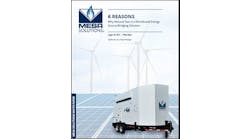It’s becoming increasingly clear that electric vehicles, or EVs, create fertile ground for microgrids and vice versa.
Microgrids are being built to provide electricity for EVs in places where the grid isn’t up to the task or where EV customers seek greener or more reliable power.
Meanwhile, more microgrid developers are incorporating EV chargers into their projects, assuming those served by the microgrid will eventually, if not immediately drive electric vehicles.
Given this synchronicity, a new report by Arthur D. Little that ranks countries for EV readiness is likely to be of interest to the microgrid community.
Spoiler alert. Americans who think we might rank high, especially since the US is home to Tesla, will be disappointed.
Even though Tesla “arguably kicked off the electric mobility movement across the globe and revived the US automotive industry,” the US ranks in only the second tier for EV readiness, according to “Global Electric Mobility Readiness Index — GEMRIX 2022.”
How to become the Norway of EVs
Norway may offer some lessons for the US. The northern European country tops the list, a fascinating twist since oil is the main source of the country’s wealth with the government managing a $1.3 trillion oil fund on behalf of its citizens. Norway is the only country where EVs make up more than 50% of vehicle sales. The report gave a nation a score of 100 if its drivers accrue equivalent benefits from driving EVs as internal combustion engine (ICE) vehicles. Norway scored a whopping 115, making Norway the “only country where driving EV is more beneficial than driving ICE,” the report said.
There were several reasons why Norway excels. Buyers have access to the greatest number of EV models. Tax breaks can cut the cost of a $50,000 EV to $40,000. The government has used some of its wealth to install a robust EV charging infrastructure, an effort begun over a decade ago. And it has created a clear roadmap for the future by becoming the first country to ban combustion vehicles beginning in 2025. It helps too that 84% of Norwegians live in cities, which reduces the likelihood of range anxiety.
China, Germany, UK, and Singapore come next as nations where EVs are on the verge of becoming mainstream. Also first tier countries, they are Norway’s “ambitious followers,” according to the report.
The next category down, “emerging EV markets,” lists the US along with Japan, UAE, and Thailand. In these countries, EVs are still an inferior alternative to combustion vehicles, but customers are becoming more comfortable with the idea.
Why is the US second tier when it comes to EVs?
Only about 1% of the more than 280 million passenger vehicles in the US are electrified, according to the report. The nation has a dearth of charging stations – about one or two charge points per 621 miles — with the coasts offering better coverage than the central parts of the country.
Another big problem is electric distribution infrastructure. Most US homes are served by a single-phase power supply, which limits charging options. EV chargers may exceed the home’s electric capacity so the homeowner may need to upgrade their electrical system’s amps.
“This creates one of the largest challenges in the US,” said the report, citing range anxiety as the second.
But the news isn’t all bad for the US.
The report finds the US has “macro factors” that make it fertile ground for EVs. These include:
—Adequate disposal income to purchase EVs, as evidenced by high GDP per capita (near $70,000) and 3% GDP growth over the last three years
—One of the highest global motorization rates, with nearly 850 cars per 1,000 inhabitants
—A high smartphone penetration of 82%, indicating an affinity to innovation
—More than 100 plug-in models available for purchase in 2021 with new entrants flocking to the market
New US climate law will help
The report also credited the Biden administration for supporting EVs and creating aggressive goals for adding more charging infrastructure. In an email, the report’s lead author, Philipp Seidel, noted that the research for the report was done prior to Biden signing the Inflation Reduction Act on August 16, which created a host of new incentives for EVs.
“My view is that in the US, the directional impact of administrations in the last years was very strong on energy/climate/transport related areas (see Trump vs. Biden administrations). I think that a transition to EVs with related aspects like V2G and renewables will happen faster with current legislation but may be impacted in reverse by any change of the political agenda over the next years again,” he said.
Making EVs cool
While there are a lot of rational reasons to drive an EV, the report points out that their perceived “coolness” or lack thereof, also plays a role
The “coolness” of driving an electric car is a determining factor primarily in Europe and North America, the report said. And unfortunately, it goes the other way too. For some, EVs just aren’t cool. In parts of the US for “much of the population, especially in the central states, ICE cars remain the emotionally and economically preferred option,” the report said.
This may indicate another way microgrids can enhance EV adoption in the US. Survey work by the Civil Society Institute shows that political liberals and conservatives share a predilection for microgrids. Could incorporating more microgrids with EV charging stations help EVs play in Peoria?
Track news about EVs and microgrids. Subscribe to the free Microgrid Knowledge Newsletter.







